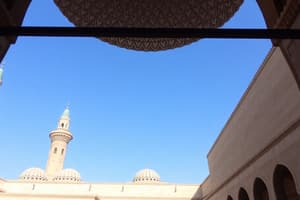Podcast
Questions and Answers
ما هو رمز المقرر الدراسي الذي يعتبر متطلباً سابقاً لمقرر تاريخ العمارة (2) ARC261؟
ما هو رمز المقرر الدراسي الذي يعتبر متطلباً سابقاً لمقرر تاريخ العمارة (2) ARC261؟
ARC161
ما هي الفترات الإسلامية المتعاقبة في مصر التي يغطيها مقرر ARC261؟
ما هي الفترات الإسلامية المتعاقبة في مصر التي يغطيها مقرر ARC261؟
العصر الطولوني، الفاطمي، الأيوبي، المملوكي والعثماني.
اذكر أمثلة على أنواع العمارة الدينية والعلمانية التي يتم اختيارها للدراسة في مقرر ARC261.
اذكر أمثلة على أنواع العمارة الدينية والعلمانية التي يتم اختيارها للدراسة في مقرر ARC261.
المساجد، المدارس، القصور، الخانات (الكاروانسرايات).
امتدت الدولة الإسلامية من _____ وآسيا الوسطى شرقاً إلى الأندلس وبلاد المغرب غرباً.
امتدت الدولة الإسلامية من _____ وآسيا الوسطى شرقاً إلى الأندلس وبلاد المغرب غرباً.
صواب أم خطأ: كانت الأساليب المعمارية موحدة في جميع أنحاء الدولة الإسلامية الواسعة.
صواب أم خطأ: كانت الأساليب المعمارية موحدة في جميع أنحاء الدولة الإسلامية الواسعة.
اذكر ثلاثة من المناطق السبع النموذجية المبرزة لدراسة العمارة الإسلامية.
اذكر ثلاثة من المناطق السبع النموذجية المبرزة لدراسة العمارة الإسلامية.
كيف توصف العمارة بالنسبة للحضارة والهوية؟
كيف توصف العمارة بالنسبة للحضارة والهوية؟
بدأت العمارة الإسلامية ببناء المساجد و_____.
بدأت العمارة الإسلامية ببناء المساجد و_____.
ما هو نوع المبنى الذي يعتبر حجر الزاوية في تطور العمارة الإسلامية؟
ما هو نوع المبنى الذي يعتبر حجر الزاوية في تطور العمارة الإسلامية؟
ما هو الخانقاه؟
ما هو الخانقاه؟
ما هو البيمارستان؟
ما هو البيمارستان؟
'المحور الشكلي' في العمارة الإسلامية يختزلها في أشكالها الأكثر رواجاً مثل _____ والقباب والأقبية والأفنية والأواوين.
'المحور الشكلي' في العمارة الإسلامية يختزلها في أشكالها الأكثر رواجاً مثل _____ والقباب والأقبية والأفنية والأواوين.
ما هو الإيوان؟
ما هو الإيوان؟
يرى المحور الروحاني الصوفي في التاريخ المعماري الإسلامي انعكاساً مباشراً لنظريات _____.
يرى المحور الروحاني الصوفي في التاريخ المعماري الإسلامي انعكاساً مباشراً لنظريات _____.
يرى المحور البيئي أن الإبداعات الإسلامية هي ردود فعل خلاقة لمعطيات البيئة من حرارة زائدة وطقس جاف وندرة في _____ والخضرة.
يرى المحور البيئي أن الإبداعات الإسلامية هي ردود فعل خلاقة لمعطيات البيئة من حرارة زائدة وطقس جاف وندرة في _____ والخضرة.
ما هي الجوانب الثلاثة التي يدمجها التعريف الأكثر رواجًا للعمارة الإسلامية؟
ما هي الجوانب الثلاثة التي يدمجها التعريف الأكثر رواجًا للعمارة الإسلامية؟
وفقًا للمنظور الأكاديمي، يمتد تاريخ العمارة الإسلامية تقريبًا من القرن _____ الميلادي حتى أوائل القرن _____ الميلادي.
وفقًا للمنظور الأكاديمي، يمتد تاريخ العمارة الإسلامية تقريبًا من القرن _____ الميلادي حتى أوائل القرن _____ الميلادي.
جغرافيًا، تشمل العمارة الإسلامية مناطق كانت تاريخيًا جزءًا من دار الإسلام، مثل الأندلس و_____، بالإضافة إلى مناطق تأثرت بها ثقافيًا.
جغرافيًا، تشمل العمارة الإسلامية مناطق كانت تاريخيًا جزءًا من دار الإسلام، مثل الأندلس و_____، بالإضافة إلى مناطق تأثرت بها ثقافيًا.
صواب أم خطأ: ظلت العمارة الإسلامية ثابتة ولم تتغير عبر التاريخ.
صواب أم خطأ: ظلت العمارة الإسلامية ثابتة ولم تتغير عبر التاريخ.
من هم 'المستشرقون'؟
من هم 'المستشرقون'؟
ما هي الفئات الثلاث التي يمكن تقسيم العمارة إليها في الإسلام بناءً على الحكم الشرعي؟
ما هي الفئات الثلاث التي يمكن تقسيم العمارة إليها في الإسلام بناءً على الحكم الشرعي؟
تحت أي فئة من فئات العمارة في الإسلام يندرج بناء الأضرحة الفخمة على القبور؟
تحت أي فئة من فئات العمارة في الإسلام يندرج بناء الأضرحة الفخمة على القبور؟
تحت أي فئة تندرج زخرفة المساجد المفرطة التي تؤدي إلى الإسراف وهدر الأموال؟
تحت أي فئة تندرج زخرفة المساجد المفرطة التي تؤدي إلى الإسراف وهدر الأموال؟
ما الذي يميز 'العمارة الإسلامية' وفقًا لهذا التصنيف؟
ما الذي يميز 'العمارة الإسلامية' وفقًا لهذا التصنيف؟
Flashcards
العمارة الإسلامية
العمارة الإسلامية
انتقال العمارة من البوادي إلى المدن مع الحفاظ على الهوية الثقافية والجمالية.
تنوع العمارة الإسلامية
تنوع العمارة الإسلامية
الأنماط المعمارية تختلف، تختلف مواد البناء، وأنواع الأعمدة، والزخارف.
مناطق انتشار العمارة الإسلامية
مناطق انتشار العمارة الإسلامية
شبه الجزيرة العربية، بلاد الشام، مصر، إيران، الهند، الأندلس، تركيا.
العمارة كوعاء للحضارة
العمارة كوعاء للحضارة
Signup and view all the flashcards
مكونات العمارة الإسلامية الأولى
مكونات العمارة الإسلامية الأولى
Signup and view all the flashcards
ماهية العمارة الاسلامية
ماهية العمارة الاسلامية
Signup and view all the flashcards
المحور الروحاني في العمارة
المحور الروحاني في العمارة
Signup and view all the flashcards
المحور البيئي في العمارة
المحور البيئي في العمارة
Signup and view all the flashcards
المجال الثاني للعمارة
المجال الثاني للعمارة
Signup and view all the flashcards
النظرة الجغرافية للعمارة
النظرة الجغرافية للعمارة
Signup and view all the flashcards
عمارة غير إسلامية
عمارة غير إسلامية
Signup and view all the flashcards
العمارة الإسلامية
العمارة الإسلامية
Signup and view all the flashcards
البيمارستان
البيمارستان
Signup and view all the flashcards
فترة العمارة الإسلامية
فترة العمارة الإسلامية
Signup and view all the flashcards
الخانقاه
الخانقاه
Signup and view all the flashcards
التعريف المعاصر للعمارة الإسلامية
التعريف المعاصر للعمارة الإسلامية
Signup and view all the flashcards
الأشكال البارزة في العمارة الإسلامية
الأشكال البارزة في العمارة الإسلامية
Signup and view all the flashcards
Study Notes
- Lecture 1 introduces Islamic architecture, focusing on its early stages
Course Information
- The course code is ARC261, titled "History of Architecture (2)."
- The prerequisite for the course is ARC161.
- The course provides two lecture hours per week.
- Course assessment includes coursework (60%) and a written exam (40%).
Course Description
- The course explores the evolution of Islamic architecture from the 7th century AD to the present.
- The geographical scope extends from the Arabian Peninsula to Spain and India.
- Focus is given to analytical studies of architecture from successive Islamic periods in Egypt.
- The periods include: Tulunid, Fatimid, Ayyubid, Mamluk, and Ottoman.
- The course illustrates the unity of Islamic architectural expression within each period's culture and environment.
- Examples from religious and secular architecture will be presented (Masjids, Madrasas, Palaces, and Caravanserais).
- Field trips are an integral part of the instructional program.
Islamic Architecture: Geographical Extent
- Islamic architecture is widespread.
- It stretched from India and Central Asia in the east to al-Andalus and North Africa in the west.
- It also extended from southern Italy and Sicily in the north to Yemen in the south.
Diversity in Islamic Architectural Styles
- Architectural styles in the vast Islamic world were not uniform.
- These styles varied across the long centuries of Islamic art.
- Variations are evident in building materials, column types, capitals, arches.
- Variations are evident in minarets, domes, pendants, and muqarnas.
- Variations are evident in geometric, vegetal, and calligraphic ornamentation.
- Variations are evident in materials used for wall coverings like plaster and Qashani tiles.
Seven examples
- Arabian Peninsula.
- Levant and Palestine.
- Egypt.
- Iran.
- India.
- Spain/al-Andalus.
- Turkey.
Essence and Characteristics
- Islamic architecture encapsulates civilization, reflecting its cultural identity and aesthetic level.
- Islamic architecture adapted from nomadic dwellings to urban buildings.
- Islamic architecture preserved original traits while accommodating human needs and traditions.
- Islamic arts share a universal unity; any piece reflects the widespread Islamic civilization.
- This unity is a key to superiority of Islamic civilization, imprinting artistic products with a shared identity.
Islamic Architecture: The Beginning
- Islamic architecture began with building mosques and "Arribat" (fortified monasteries).
- Later: schools, oratories, hospitals, fountains, libraries, lodges and other civic structures appeared.
- The mosque serves as the cornerstone of Islamic architectural development.
- "Arribat": Structures in Jerusalem during the Ayyubid and Mamluk periods for those devoted to Al-Aqsa.
- "Arribat" Became residences for poor students of science.
- "Khanqah": A place where the Sufi isolates for worship, requiring a special layout blending mosque and school design with private rooms for retreat ("Al-Khalawi").
- "Takia": Egyptian alms-house where food is prepared and offered to the poor.
- "Bimaristan": Persian word for hospital and medical school, meaning "place of assembly".
Core Conception
- The first domain: Historical- Architectural and Emotional.
- It depends on three axes
Conceptual Framework: The Historical-Architectural and Emotional Domain
- The first axis: formal.
- The formal axis encapsulates the most stylish forms.
- The formal axis is arches, domes, vaults, interior courtyards, "Iwans," mashrabiyas,
- The formal axis gives these shapes special Islamic functions.
- These functions connect to core Islamic thought.
- These functions express unified origins, features, purposes, and shared religious, social climate.
- The second axis: the spiritual- Sufi axis.
- The second axis manifests Sufi influence within Islamic architectural designs.
- The second axis is used by great Sufis, such as Ibn Arabi and Jalaluddin Rumi.
- The second axis employs symbolic expressions without direct historical affirmation of Sufi ideas on architectural forms.
- The third axis: environmental.
- The third axis emphasizes tie between Islamic innovation and its environment, specifically in popular and rural creations.
- The third axis addresses challenges like heat, aridity, and scarce resources.
- The arid climate is a common feature across Islamic regions.
- All three axes intersect, defining Islamic architecture.
- All three axes focus on unique historical forms, Sufi spirituality, and climatic responses to arid desert settings.
Academic Study: Historical and Geographical Dimensions
- Extended from the 7th century (rise of Islam) to the early 19th century.
- The 19th century was the start of European conquest of most Islamic lands.
- The effects of the European conquest continued with Western dominance, art, and culture after liberation.
- The geographical dimension acknowledges Islamic architecture in Islamic cities and regions. Islamic cities and regions include areas ruled by Islamic civilizations.
- The Islamic regions were those later lost to other civilizations (e.g., Andalusia, Sicily).
Academic Study (Cont.)
- The Islamic regions included those incorporated later (e.g., Turkey, Bosnia, Malaysia, parts of China and Africa).
- Essential to recognise that Muslim architecture was a product.
- The Muslim architecture was built for their environmental and social needs.
- Over time, this style mixed with the underlying thought that dictates behavior.
- Over time, this style evolved as circumstances shifted, never settling but forever changing.
- Islamic architecture is a product of and testament to history.
- Orientalists studied Islamic heritage extensively by reading records.
- Orientalists examined documents describing landmarks, histories, royal biographies, and traveler accounts.
- They pinpointed locations.
- They captured details on paper through interpretation, classification, and diagrams.
Categories of Islamic Architecture
- In Islam, architecture can be divided into three categories.
- Not Islamic.
- Undesirable.
- Islamic.
Defining Islamic Architecture Categories
- "Not Islamic" architecture: architecture that violates clear Islamic principles, such as shrines.
- "Not Islamic" architecture also includes constructions on graves or buildings that expose Muslims.
- It does not matter if these are built by Muslims.
- "Discouraged" architecture: architecture that includes decoration of mosques and excess.
- "Discouraged" architecture includes extravagance considered a waste of resources.
- "Islamic architecture": architecture that adheres to the teachings of Islam in its construction.
Studying That Suits You
Use AI to generate personalized quizzes and flashcards to suit your learning preferences.




